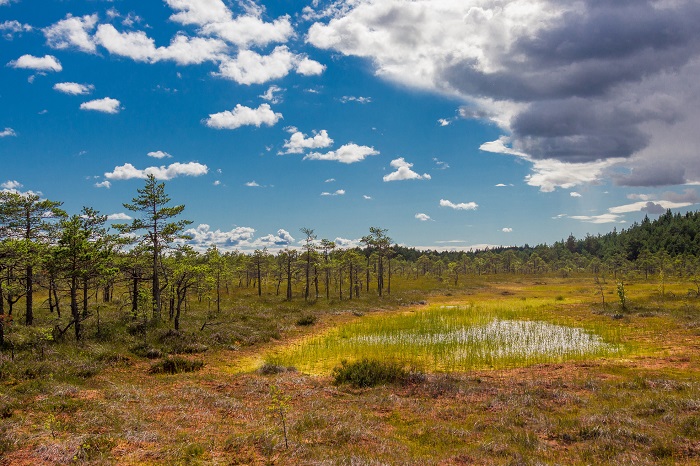The first nature reserve in Estonia and the Baltics was established in 1910 under the leadership of Artur Toom
Early nature conservation
It is difficult to accurately determine the beginning of the history of Estonian nature conservation. It is believed that sacred natural sites (for example, sacred groves, springs, rocks) have been worshipped in Estonia for thousands of years [1]. The principles of sustainable logging were first established in Estonia by the Swedish Forest Act, which entered into force in 1664.
In 1853, the Estonian Naturalists’ Society was established, which, especially its section on nature conservation, established a century ago, plays a major role in the study and registration of natural monuments to this day.
The world’s first national park, Yellowstone, was established in the United States in 1872. The first national parks in Europe were created in Sweden in 1909 [2]. The first nature reserve in Estonia and the entire Baltics was established under the leadership of the Riga Naturalist Society and Artur Toom on 14 August 1910 on the Vaika islands to protect the bird population there. The Vaika islands are located in the current Vilsandi National Park, and the establishment of the Vaika bird sanctuary is considered to be the beginning of modern nature conservation in Estonia.
The early Republic of Estonia
Data on nature began to be systematically compiled and a national system of nature conservation was established in the early years of the Republic of Estonia. In 1920, the section on nature conservation of the Estonian Naturalists’ Society was established with the purpose of studying natural monuments in Estonia. Botanist Gustav Vilbaste, the first nature conservation inspector, played an important role in this. Many reserves and protected areas were formed then. In 1935, the first Estonian nature conservation law entered into force. All protected areas and protected objects (such as the Tamme-Lauri oak) were entered in the nature conservation register. By 1941, there were a total of 523 nature conservation areas and individual natural objects, in addition to 26 protected species.
The time of the occupation
After World War II, the national organisation of nature conservation gradually recovered and nature conservation developments continued – hunting protection areas were established and many new nature conservation areas were created. Nature conservation became more socially active, but also more science-based. The Estonian Society for Nature Conservation was established and the Nature Conservation Commission of the Estonian Academy of Sciences, headed by ornithologist Eerik Kumari, became the science-based leader and organiser of nature conservation.
In 1957, the Vaika, Viidumäe, Matsalu, and Nigula state nature reserves were established, and in the same year, the Nature Conservation Act of the Estonian SSR entered into force as the first national nature conservation law of the Soviet Union. This established the Nature Conservation Government, the predecessor of the Ministry of the Environment.
In 1966, the Estonian Society for Nature Conservation was established, the first leader of which was Jaan Eilart and which became the largest public nature conservation organisation in Estonia.
The 1970s were important in Estonian nature conservation – it was realised then that it is more reasonable to protect nature internationally than in each country individually. As far as possible, Estonia started participating in international nature conservation and using internationally recognised nature conservation principles. Estonia started cooperating with the International Union for Conservation of Nature (IUCN), established in 1948. In 1971, the first national park was established in Lahemaa, which was the first in the entire Soviet Union, whereas in 1979, the first Estonian Red Book (i.e. Red List, 1979), which became the basis for organising species protection, was compiled.
As a result of the deterioration of the environment, the awareness of the public and social activity began to rise. Under the leadership of professor Viktor Masing, the so-called war for the mires began, resulting in putting an end to the mass drainage of mires and the creation of 20 mire protection areas.
In 1987, the so-called Phosphorite War began. It was a popular resistance movement based on the motives of nature conservation, opposing the policy of the central government in Moscow of starting mining phosphorite in Estonia. As a result of the Phosphorite War, the Pandivere water protection area was established, but the most important result was the Singing Revolution and the regaining of the independence of the Republic of Estonia that followed immediately after.

The period after regaining our independence
After we regained our independence in 1991, the attempts began to reorganise the Estonian nature conservation system. The Protected Natural Objects Act entered into force and new areas were protected. Among other things, several new national parks were created – Soomaa, Karula – and Vilsandi was named a national park instead of nature reserve. Estonia acceded to international nature conservation conventions, such as the conventions of Bern, CITES, Ramsar, and the Convention on Biological Diversity.
In the 1990s, the entire state government in Estonia was reorganised. Although nature conservation activities continued in the areas taken under protection during the Soviet era, the principles of conservation of various protected areas were harmonised. The land and ownership reform took place, which also had to be taken into account in the nature conservation system, and much of the land went into private ownership.
The next big change came when Estonia acceded to the European Union in 2004. Estonia joined the pan-European network of protected areas, Natura 2000, in connection with which the Estonian nature conservation system and legislation were amended to meet the requirements of the European Union’s Birds and Habitats Directive (for example, the Nature Conservation Act entered into force). During this process, natural values were inventoried and a large number of new areas were protected. Matsalu nature reserve was transformed into a national park.
The Estonian Red List has also been updated once every decade (in 1988, 1998, 2008, and 2018).
Last modified: 02.12.2021
____________________________________________
[1] Ülevaade looduslikest pühapaikadest: http://hiiepaik.ee/vaata/kaardistame-eesti-puhapaigad-esitlus/
[2] Looduskaitsekuu: https://keskkonnaamet.ee/keskkonnateadlikkus-avalikustamised/kampaaniad/looduskaitsekuu#milline-on-looduskai